Using binoculars for astronomy and stargazing is becoming increasingly popular as users realise their benefits over a bulky telescope.
Binoculars make astronomy more convenient, more accessible and more spontaneous.
Here we'll look at the advantages of choosing binoculars for this purpose and reveals what to look for in a pair of binoculars that are to be used for stargazing.
We'll also discuss the astronomy and stargazing sights that can be explored using binoculars, including the Moon, our Galaxy and the features within it, other galaxies, Jupiter and Saturn and sights that are especially appealing targets for stargazing in the summer months.
With this information, binocular users should be well prepared to start their own adventures exploring the night sky.
If you are already set on getting a modest pair, read our pick of the top binoculars for astronomy beginners or get something quality but affordable with our pick of the best budget binoculars.
And if you've just recently picked up an old forgotten pair that have been lying around the house, read our guide on how to clean binoculars.
Complete newcomer? Read our guide to astronomy for beginners
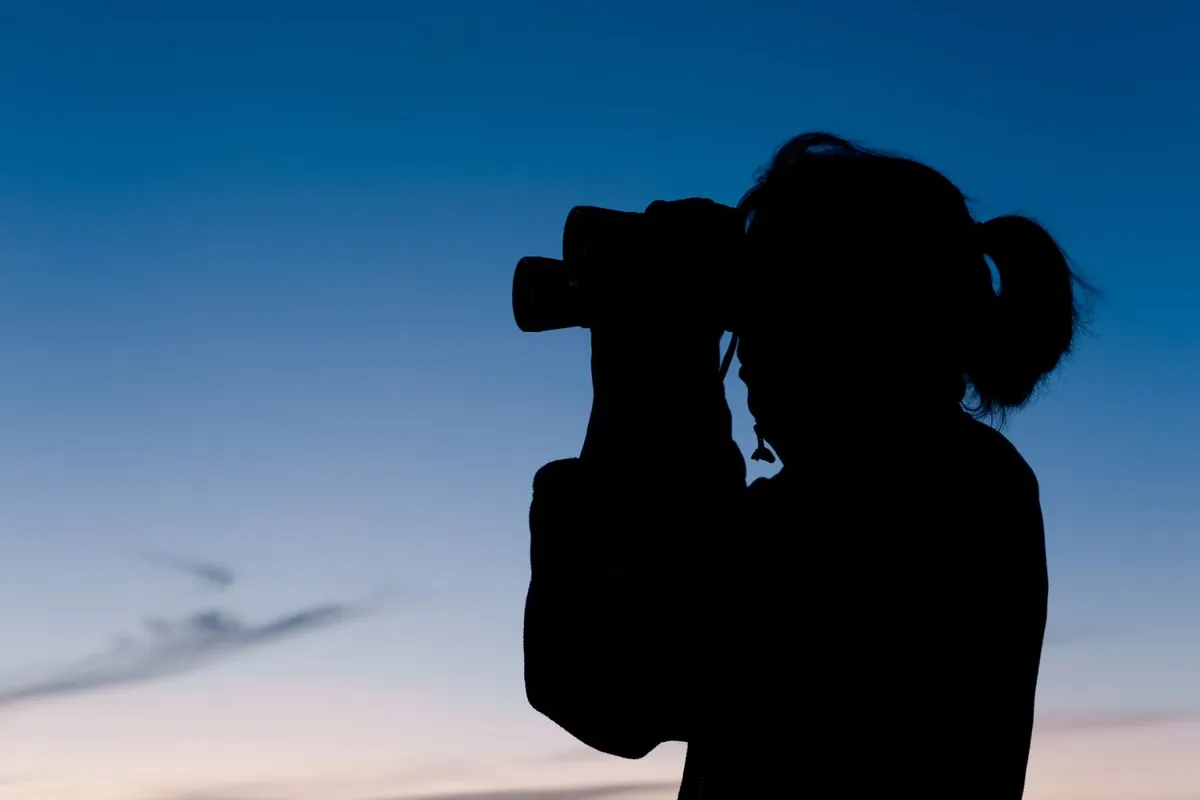
Why binoculars are good for astronomy and stargazing
For astronomy and stargazing, binoculars offer a number of advantages that make them superior to large telescopes.
Binoculars actually consist of two smaller telescopes that are joined together to provide stereo images to your eyes.
Binoculars have three main benefits over telescopes: cost, ease of use and portability:
Cost
Instead of making a big financial investment in a complex piece of equipment like a telescope that may be challenging to set up and learn to use, binoculars provide an easy and immediate low-cost entry point into the fascinating world of stargazing.
The affordability of binoculars also means that unlike a single telescope, more than one set of binoculars can be purchased so that stargazing can become a fun, communal activity for more than just one person at a time.
Ease of use
A major advantage of binoculars is that most people are more comfortable using both eyes when looking up into the skies, as opposed to having to squint through a telescope.
As a result, binoculars are more appealing for longer bouts of stargazing.
With a more comfortable and natural feel, binoculars are great for families with older children interested in astronomy.
They also give viewers a wider view of the sky than a telescope, meaning users are more likely to easily spot celestial objects of interest.
Due to this wider view, binoculars also give viewers a better sense of patterns in the sky, or how objects lie in reference to one another, as opposed to just focusing on one object, like with a telescope.
Portability
Telescopes are large, heavy and need to be set up on a mount and tripod, making them somewhat impractical for outdoor adventures such as overnight camping trips or expeditions away from home.
Binoculars are easy to pack and bring along for use on short weekends away, or even during international travels, and have the advantage of serving more than one purpose.
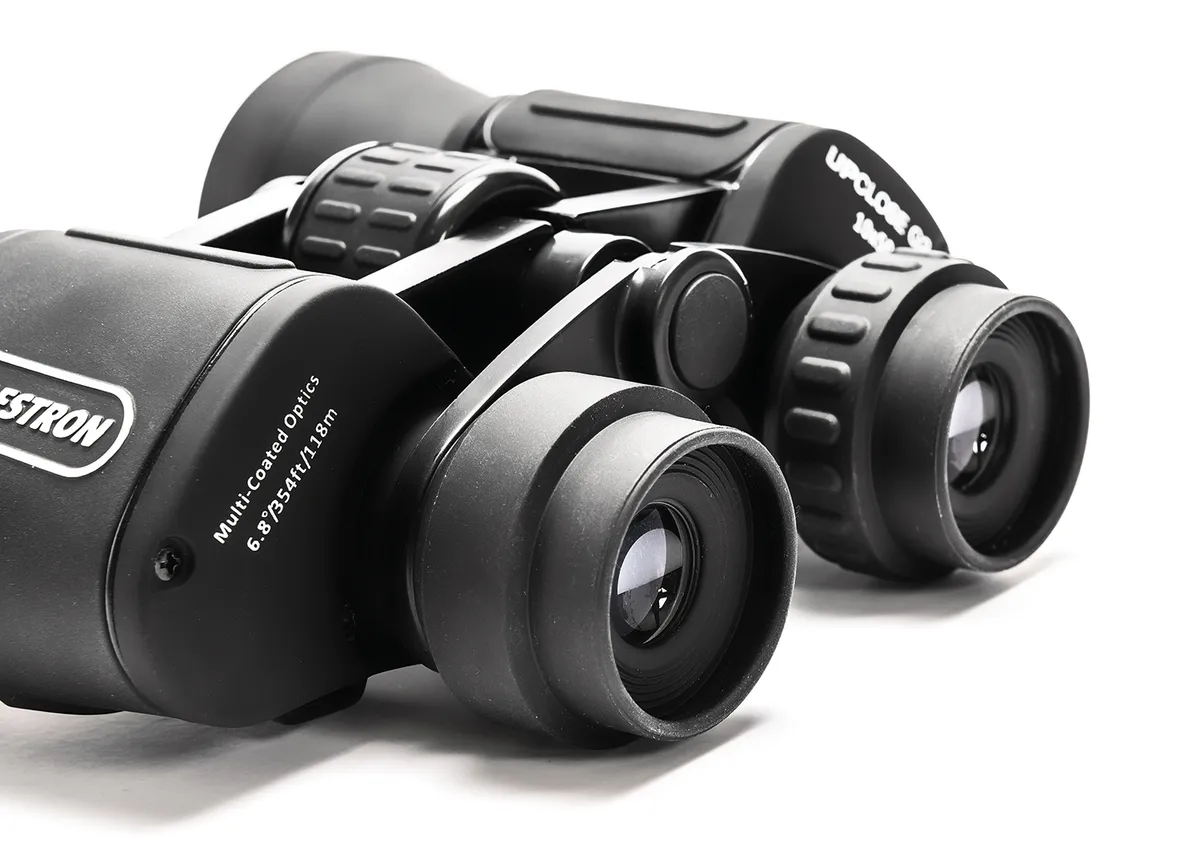
Choosing binoculars for astronomy and stargazing
The main thing to consider when choosing a pair of binoculars for astronomy and stargazing is the size of the front lenses, which determines how much light enters the binoculars.
Specs
You may have wondered what the numbers on binoculars mean. The specs of the binoculars will tell you a lot about its capabilities for astronomy and stargazing.
They indicate the field of view in either yards or degrees. If in degrees, you can calculate 52 feet for each degree to understand the capacity.
For understanding the magnification power, the first number provided is the magnification above the naked eye, and the second number is the diameter of the large lenses at the front of the binoculars in millimeters.
So, a '25 x 70' binocular provides 25 times the magnification of the object viewed by the naked eye, and achieves this with front lenses that are 70 millimeters in diameter.
One thing to keep in mind is that the higher the magnification, the dimmer the object being viewed.
A good baseline pair that combines portability, cost and ease of use would be a 10x50 pair of binoculars, although both less powerful and more powerful binoculars can also be used for stargazing.
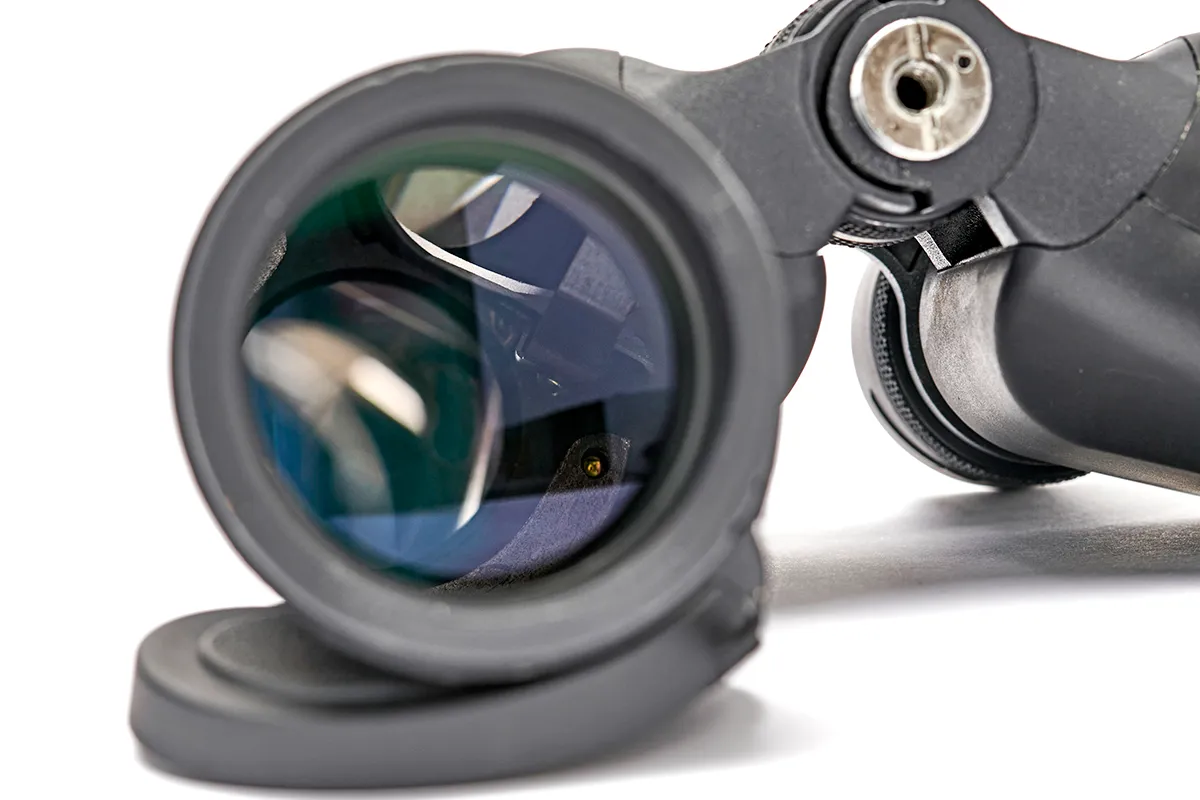
Big aperture
For astronomy and stargazing, the bigger the front lenses the better, as larger lenses will allow more light into the binoculars, and allow for spotting fainter objects in the night sky.
The front lenses of binoculars are called 'objectives', while the small lenses you look directly through are called eyepieces.
The lenses work together to let light in and direct it toward your pupil.
This 'big aperture' of the objective lens is the most important element of a binocular that will be used under low light conditions, although of course the overall quality of the optics used in the binocular will affect the level of detail in the sky that is visible as well.
If you plan to stargaze with children who cannot hold a heavy pair of binoculars, or are interested in longer periods of viewing the night sky, it may be worth selecting a pair of binoculars that have the option of being mounted onto a bracket and tripod.
You can tell whether binoculars can be attached to a bracket by looking for a mounting screw receptacle that allows you to secure the binoculars safely and securely to a bracket setup.
If you find it tricky to keep your binoculars from shaking, their are a few cheap solutions that can help. Read our guides on how to hold your binoculars steady and how to make a binocular mirror mount.
Optics and ISB
Other features you may want to look for are 'coated optics' to ensure high contrast views and brightness of image, and 'ISB' meaning 'image stabilized binoculars'.
ISB binoculars are more expensive, but the added value is that they compensate for the movement of your hands and create a more stable image without further effort on your part.
Waterproofing
A final thing to consider is whether you get a lot of rain in your region.
If so, protect your investment by selecting a pair of binoculars with waterproofing, so that a few drops of rain do not ruin an otherwise worthy night of stargazing!
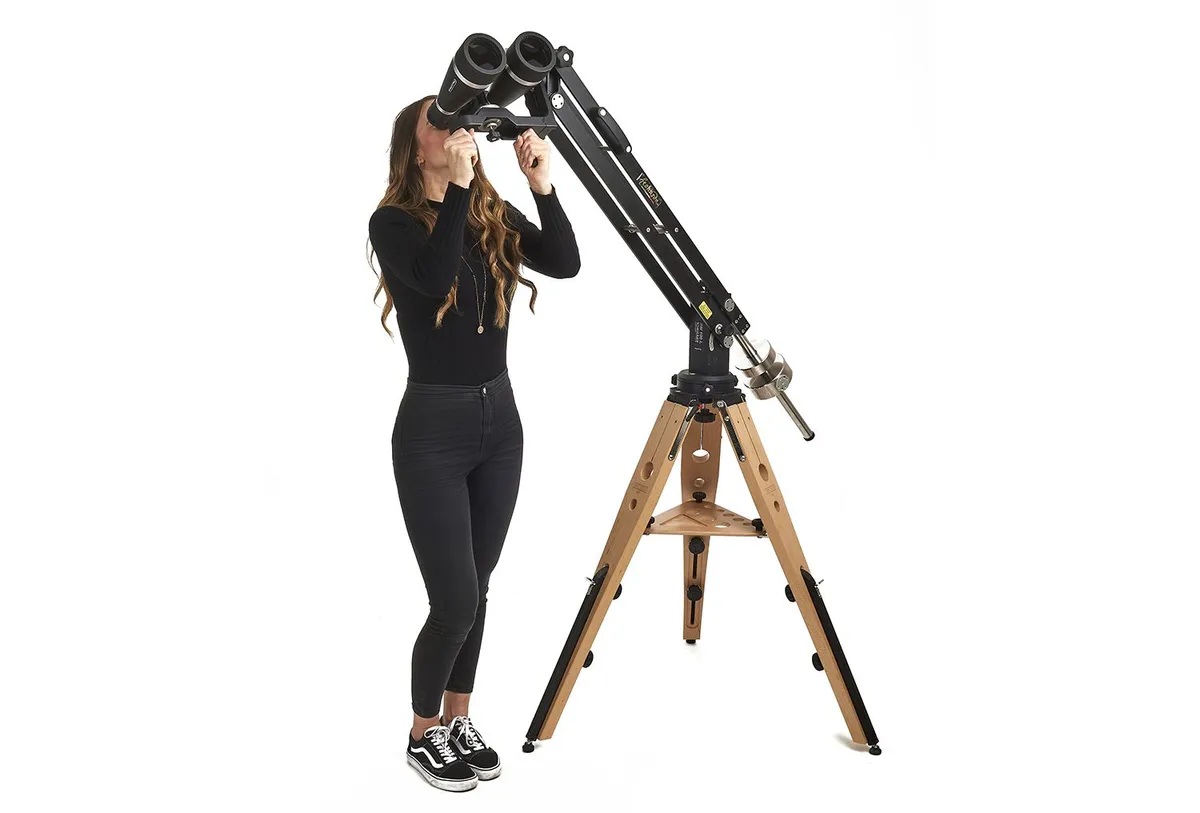
What see in the night sky with binoculars
The Moon
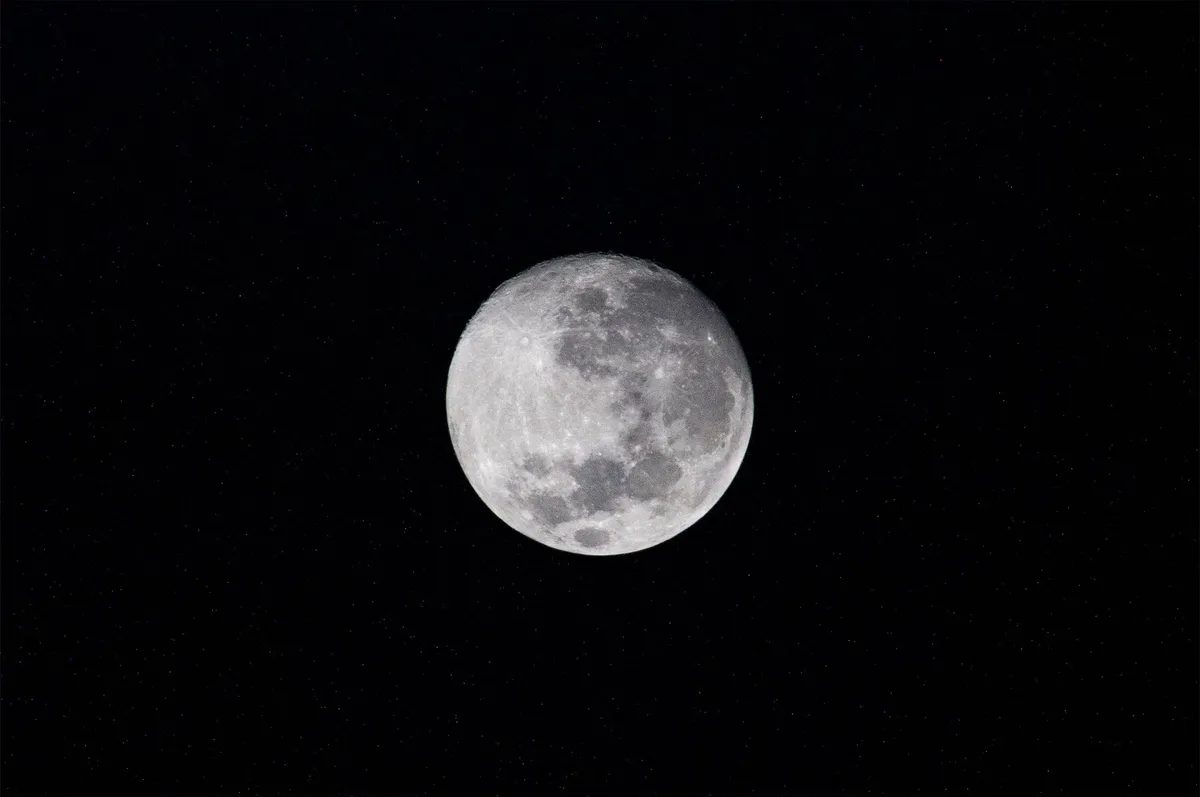
The first stop on any astronomy and stargazing tour with binoculars will be the Moon. A pair of binoculars will reveal the details of the visible features of the lunar surface, such as craters and lava plains, the dark areas called 'lunar maria'.
One of the main craters visible at the bottom of the moon is called Tycho, and is distinguished by white rays that extend from the crater.
Even when the Moon is in the waxing phase, when it looks just like a crescent sliver, binoculars will reveal the rest of the Moon's face, illuminated by light that bounces off the Earth.
One good technique to try is scanning the line that indicates day and night, known as the 'terminator'. Along this line, the features of the Moon will be most distinct.
The lunar maria, or 'seas' are another great feature to try to identify.
Major lunar maria are Mare Tranquillitatis in the northeast and Mare Nectaris and Mare Fecunditatis in the southeast.
Other highlights to search for are the Apennine mountain range and giant crater Copernicus in the northwest, and then the Clavius crater in the southwest.
Get the basics of lunar astronomy with our beginners' guide on how to observe the Moon.
Planets
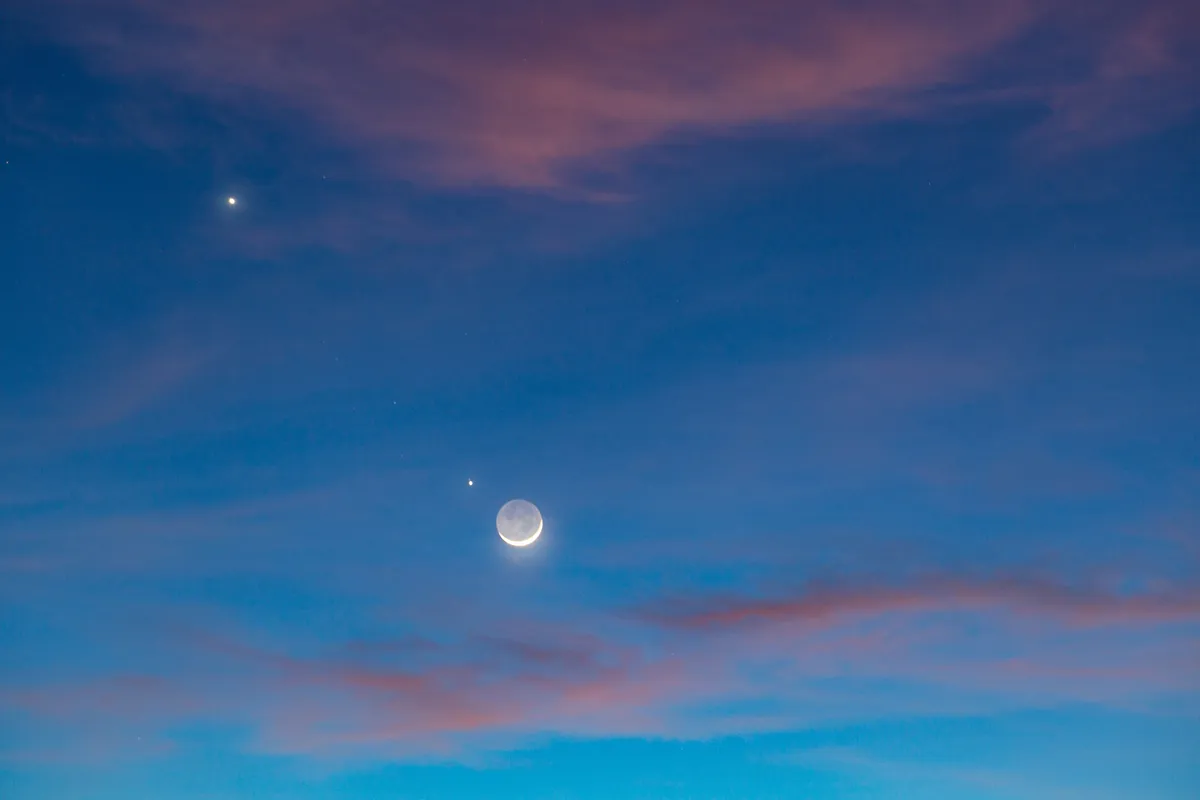
One of the most tantalising prospects of amateur astronomy is learning more about the planets.
Saturn and Jupiter are the two planets most easily sighted through binoculars, and each should be visible under the right conditions with a steady hand.
Saturn and Jupiter are two of the brightest planets that are visible even with the naked eye and make obvious movements through the sky.
For this reason, they have been popular since ancient times.
Stargazing with a smartphone is becoming more popular these days, and sky-charting apps will help locate both Jupiter and Saturn in the night sky.
Some apps are specifically tailored to track one planet. Some good apps to try are Jupiter Guide, Sky Safari 5, Gas Giants, and Sky and Telescope.
Read our pick of the best smartphone astronomy and stargazing apps.
Jupiter
Jupiter is the largest planet and therefore the easiest to spot in the night sky.
Using binoculars should reveal the four Galilean moons of Jupiter surrounding the planet: Ganymede, Europa, Io and Callisto.
These moons will look like four pinpricks of light that encircle Jupiter.
One fun challenge is to monitor the location of the moons as they are constantly shifting around Jupiter, changes that should easily be visible during the course of several nights of observation.
Another benefit of seeking out Jupiter is that you do not have to wait until total darkness in the sky to look for this planet.
Jupiter's brightness allows it to be seen in twilight (and even daylight!).
If you do try to spot Jupiter in daylight, look out for a very pale disc, but take special care not to point your binoculars directly at the Sun.
Saturn
The second largest planet in our Solar System, Saturn is a spectacular planet to view through binoculars.
If you hold the pair very steady you should be able to identify an orb, though it may appear slightly more oval than circular.
Using binoculars alone it is usually difficult to see Saturn's faint rings, and this may be a challenge depending on the magnification power of your binoculars.
One easier target is Titan, Saturn's largest moon.
In order to find out where to look for Saturn, use an app or chart to identify where Saturn will fall based on the date you are observing the sky.
The Milky Way

Using binoculars, you will get an even better understanding of the astronomical formations that are our neighbours in the Milky Way.
Find out more in our guide on how to observe the Milky Way.
The first step is to find a truly dark night sky,- meaning you need to travel far from any light pollution from cities or towns.
Pick a moonless night for superior viewing conditions.
In the past, the Milky Way was visible from almost any location, however the conditions of light pollution due to modern technological development have hidden the Milky Way from proper observation in many cities and suburbs.
To get oriented towards the Milky Way, turn your attention to the glowing arc that should reach from the southern to northeastern horizon.
Expect the glow to be faint and white, with slight shadows and mottling.

You will not be able to see colours in the Milky Way because of the distance, all the shades will appear in shades of grey.
A good starting point for more detailed observation is to head left from from the bright star Deneb, and get further immersed in the fascinating features of the Milky Way.
The Milky Way provides a trove of treats for observation.
Other great features are the North America Nebula and the Messier 39 open star cluster.
The North America Nebula is named because it resembles the North American continent, and the easiest area to spot is the region of 'California'.
Other night-sky targets to see with binoculars
The Northern Coalsack
Look for the dark nebula within the Cygnus constellation, which falls near the star Deneb, to the right and below.
Messier 13
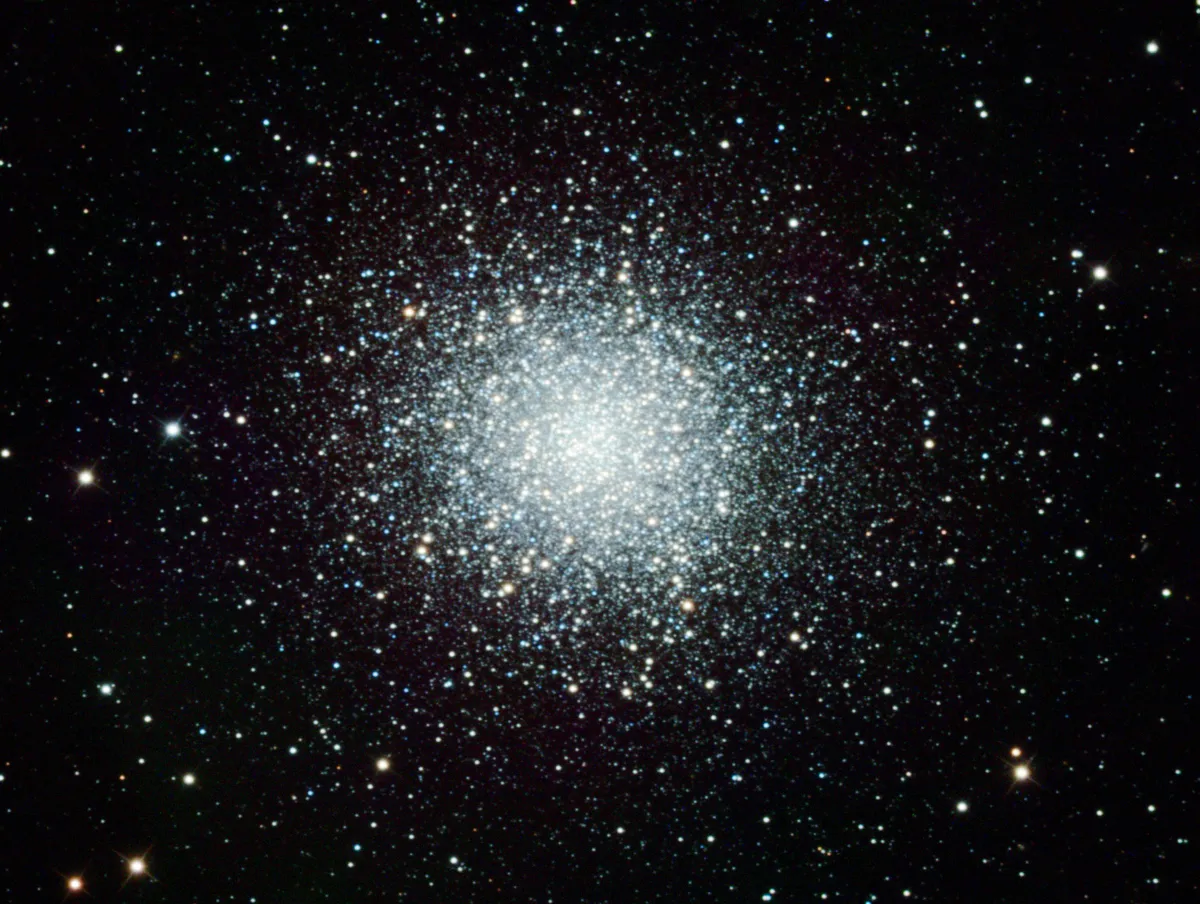
This globular cluster is also known as the Great Hercules cluster and amazingly it contains over 300,000 ancient stars.
Binoculars will reveal the wonder of this cluster, which can be found along the western edge of Hercules.
Messier 24
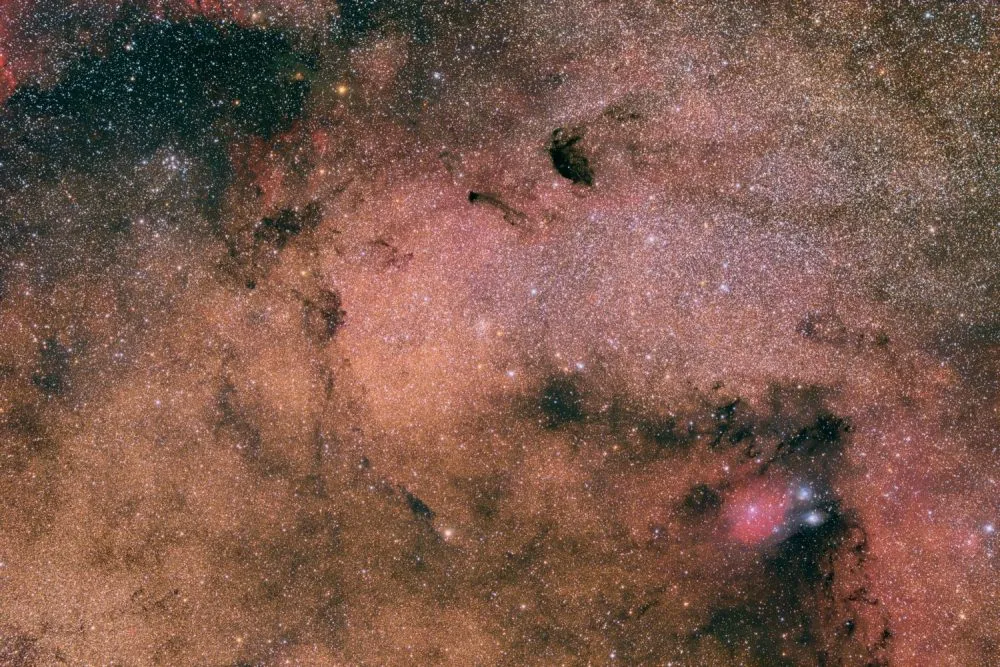
Also known as the Sagittarius star cloud, this star field is a wonderfully rich star field and can be found near the center of the Milky Way.
Many nebulae can also be spotted, including the Eagle Nebula, the Trifid Nebula, the Omega Nebula and the Lagoon Nebula.
Cassiopeia and Hercules
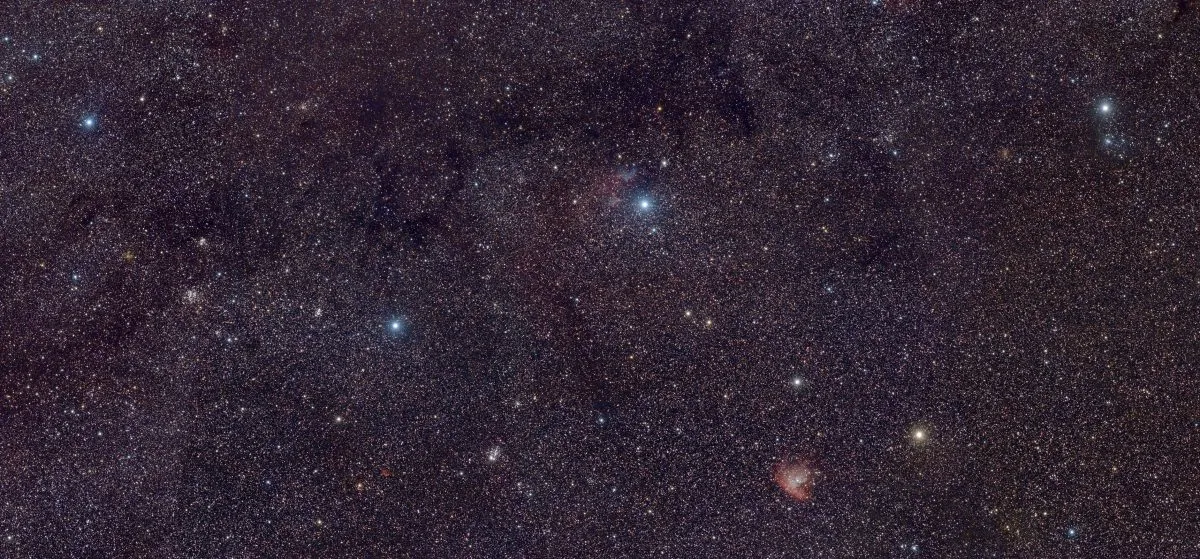
Looking for the constellations of Cassiopeia and Hercules will give perspective as to Earth's position within the spiral of the Milky Way.
As you look towards the northern arc of the Milky Way you will see that the stars are more distantly interspersed as opposed to being more tightly clustered if looking towards the denser areas near Sagittarius.
The Andromeda Galaxy
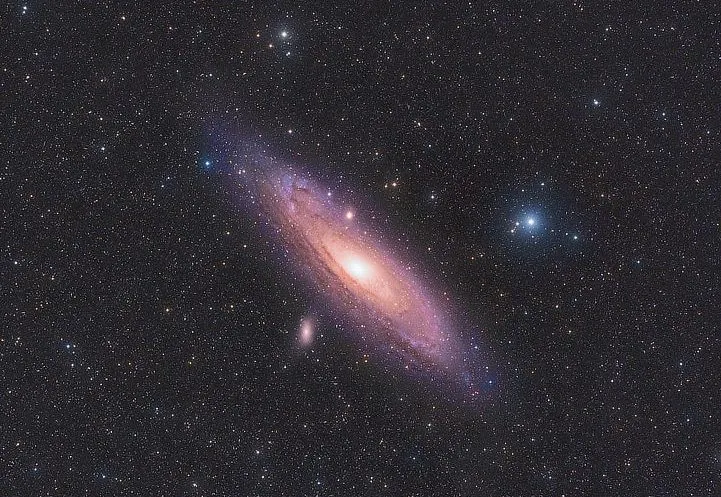
In order to achieve the goal of seeing the Andromeda Galaxy, the key is to find a particularly dark and moonless night and a viewing location with very little light pollution.
You also need to be willing to stay up a bit late!
The first step is to locate the Andromeda Galaxy in the eastern sky below Cassiopeia.
The Andromeda galaxy, or M31, will look like a tiny bit of white fluff - but this galaxy is almost twice the size of the Milky Way and can be found 2.5 million lightyears away from our planet.
A trillion stars make up this tiny piece of fluff, which helps make it visible even to the naked eye.With binoculars, however, you will see more detail and the long oblong shape of the Andromeda Galaxy will become visible, as well as distinction between the bright core of the galaxy and the fainter edges.
You can also see that Andromeda is a bit asymmetrical: the northern part of the galaxy will appear more robust and puffier, while the southern segment will appear less distinct.
The oldest starts are tightly compacted into the bright core of the galaxy, which is referred to as the "bulge."
M110 and M32
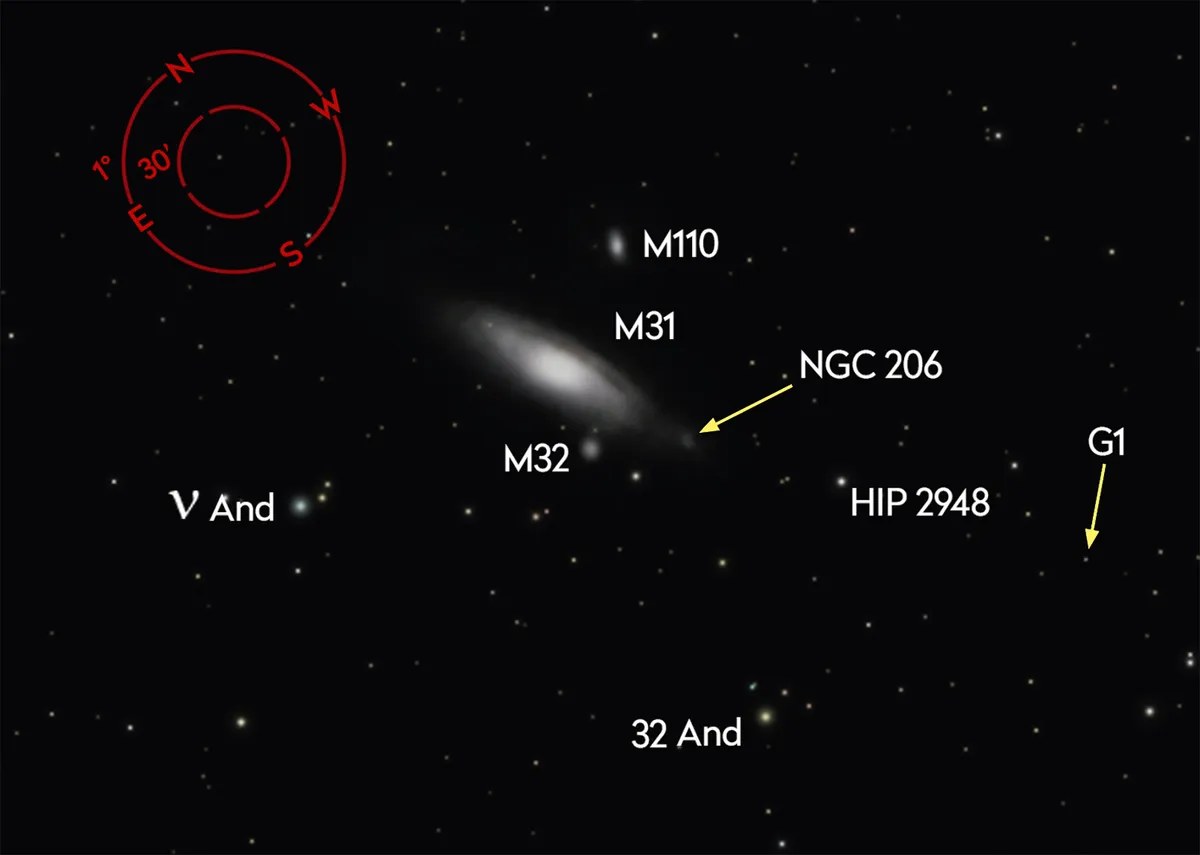
Going beyond Andromeda, you should also be able to make out the two companion galaxies that flank it, M110 and M32.
M32 is the brighter of the two companion galaxies, and can be found by identifying the three 7th magnitude stars that are near the Southern end of Andromeda.
The furthest north of these stars will point towards M32, which will be slightly less bright.
M110 is across from Andromeda past the bright side of the nucleus.M110 will not be very distinct and may look more like a haze as you first identify it.
The Triangulum Galaxy
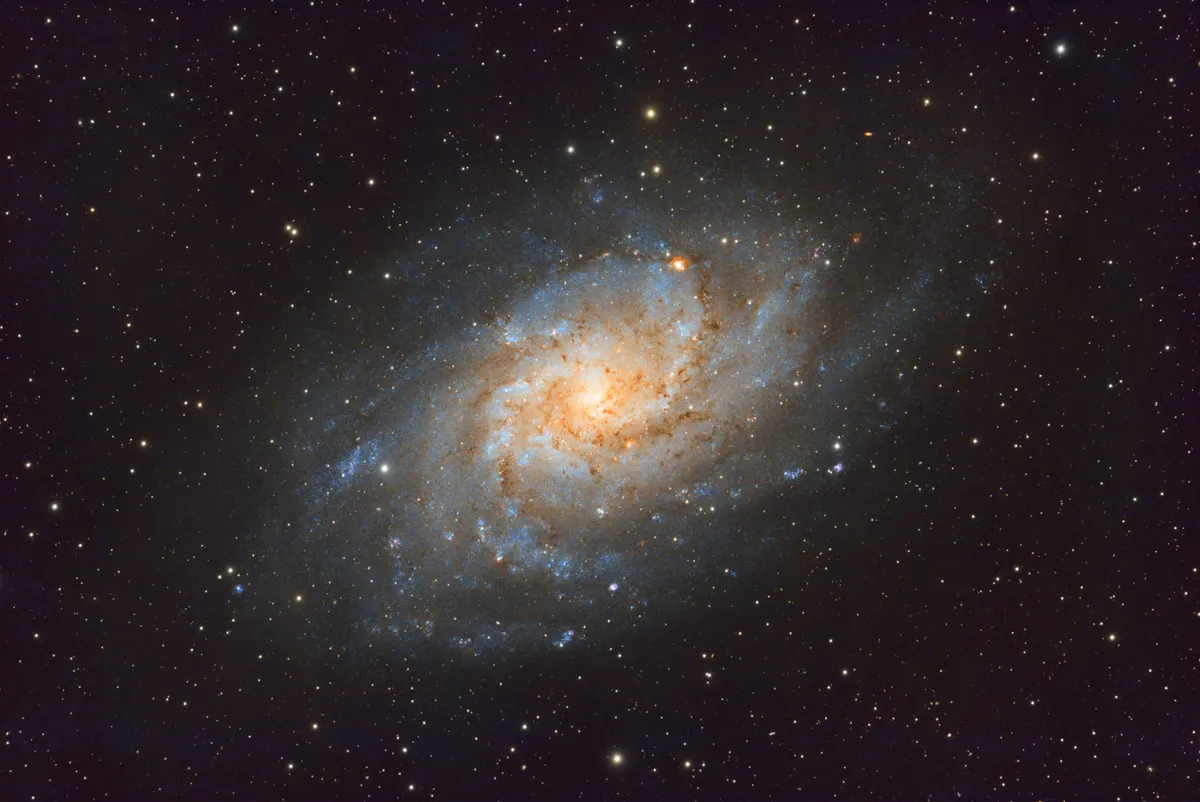
While Andromeda is better known, there is also another visible galaxy in this region: the Triangulum Galaxy, also called M33.
The constellation Triangulum is the beacon used to find this galaxy.
You can also look directly below the Andromeda Galaxy and 15 degrees southeast of M31. The Triangulum Galaxy is slightly farther away than Andromeda.
It is 2.7 million light years away, and is a spiral galaxy. Through binoculars, this galaxy will be egg shaped and appear fuzzy.
Like Andromeda, there is a brighter bulge in the center of the galaxy, but unlike Andromeda, the Triangulum Galaxy contains a relatively small number of stars, at just about 40 million.
Summer binocular targets for astronomy and stargazing
Summer is an especially ideal time to use binoculars for astronomy and stargazing, as astronomical observation can be paired with camping or hiking in areas where there is little light pollution and you can have the darkest and clearest views of the sky.
Using apps like the previously mentioned Sky Safari 5, you can find objects that are great targets for sighting during the summer months.
The Plough
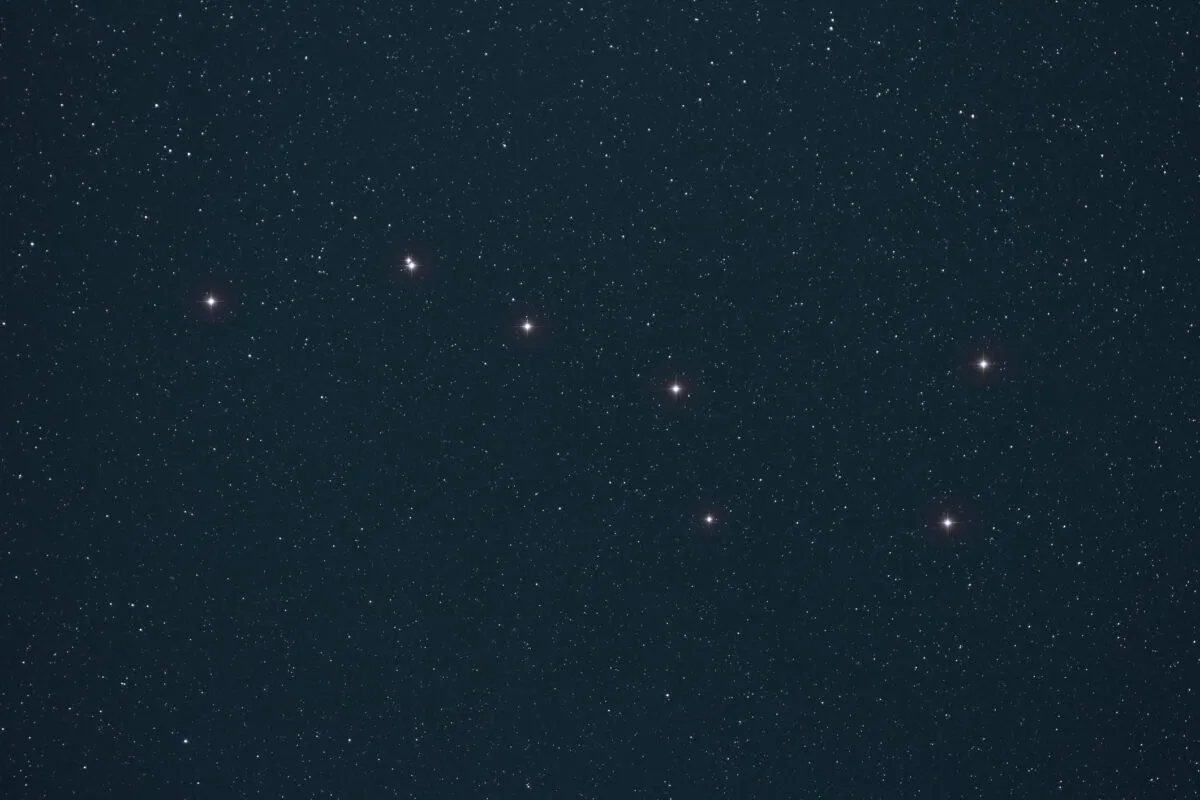
We might think of the Plough as a constellation, but it is actually called an 'asterism'. It is actually part of the larger constellation called Ursa Major.
The Plough is a familiar sight but can be enhanced by viewing through binoculars.
The stars Mizar and Alcor are particular highlights. While you are in the area, check out the Ursa Minor as well.
The naked eye, you will usually not be able to see all seven stars that make up Ursa Minor, but with binoculars you should be able to spot them all.
The Summer Triangle and Coathanger
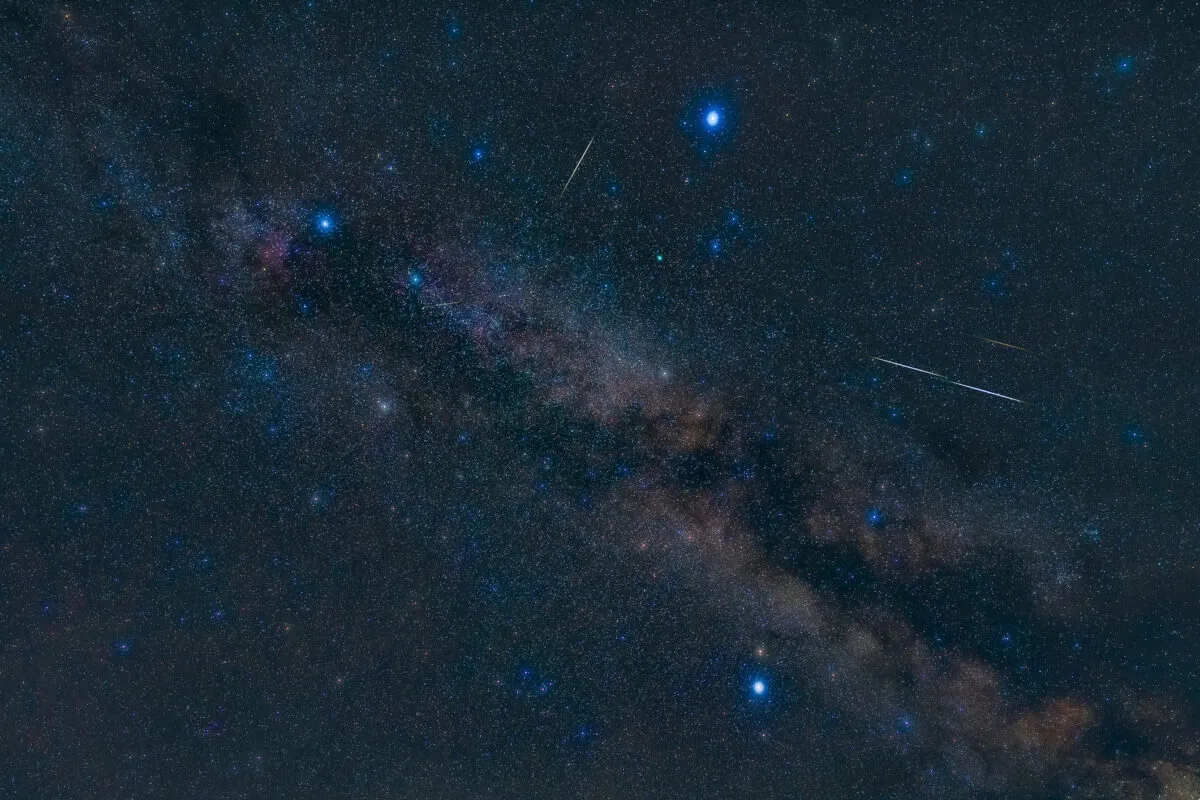
After getting the hang of the familiar Plough, expand your horizons by searching for the asterisms the Summer Triangle and Coathanger.
In the earlier part of the summer these will be identifiable by sweeping the eastern part of the night sky.
Deneb, Altair and Vega are the stars forming the Summer Triangle, while the Coathanger asterism is nestled between Altair and Vega and consists of a bar with a hook.
Epsilon Lyrae
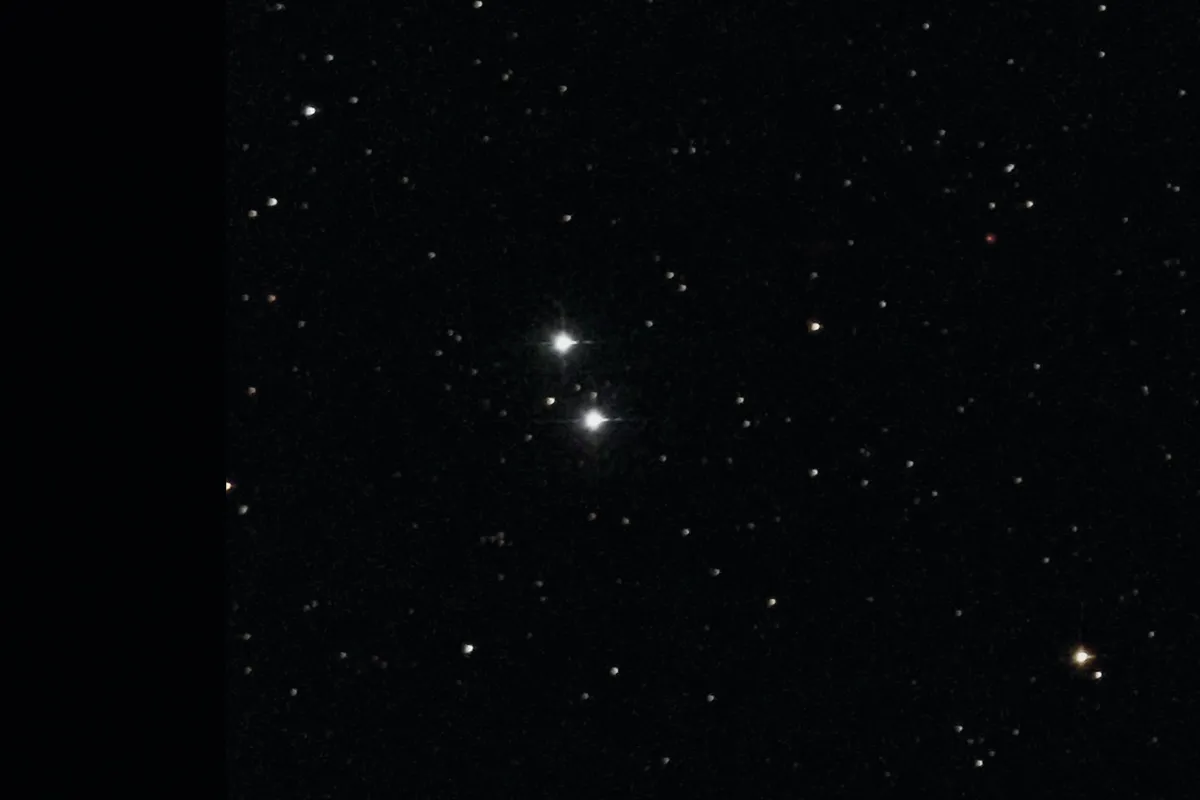
Despite the fancy name, this double star is unimpressive to the naked eye, but with binoculars, its full appeal can be revealed.
Epsilon Lyrae can be found in the constellation of Lyra, identifiable near Vega, a bright star.
Epsilon Lyrae has the nickname 'Double Double', referencing its stars Epsilon1 and Epsilon2, which themselves are also double stars.
With binoculars you will be able to see the split of Epsilon1 and Epsilon2, but not necessarily all four stars.
I hope that these tips will provide for many nights of enriching, exciting viewing of the skies above! Happy star hunting!
Jim Shickley is an avid birdwatcher, amateur astronomer and binocular expert. To find out more about binoculars and their uses, visit his website.